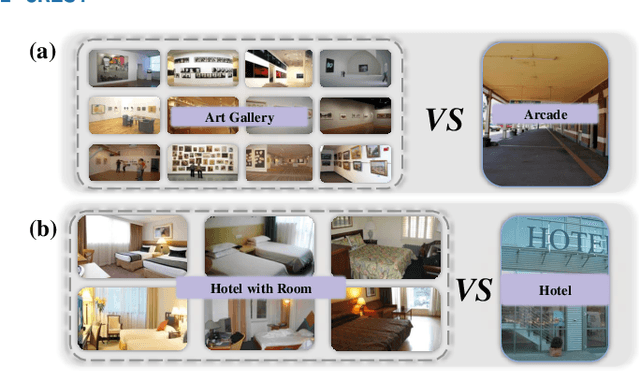Xiaozhen Qiao
Bidirectional Prototype-Reward co-Evolution for Test-Time Adaptation of Vision-Language Models
Mar 12, 2025Abstract:Test-time adaptation (TTA) is crucial in maintaining Vision-Language Models (VLMs) performance when facing real-world distribution shifts, particularly when the source data or target labels are inaccessible. Existing TTA methods rely on CLIP's output probability distribution for feature evaluation, which can introduce biases under domain shifts. This misalignment may cause features to be misclassified due to text priors or incorrect textual associations. To address these limitations, we propose Bidirectional Prototype-Reward co-Evolution (BPRE), a novel TTA framework for VLMs that integrates feature quality assessment with prototype evolution through a synergistic feedback loop. BPRE first employs a Multi-Dimensional Quality-Aware Reward Module to evaluate feature quality and guide prototype refinement precisely. The continuous refinement of prototype quality through Prototype-Reward Interactive Evolution will subsequently enhance the computation of more robust Multi-Dimensional Quality-Aware Reward Scores. Through the bidirectional interaction, the precision of rewards and the evolution of prototypes mutually reinforce each other, forming a self-evolving cycle. Extensive experiments are conducted across 15 diverse recognition datasets encompassing natural distribution shifts and cross-dataset generalization scenarios. Results demonstrate that BPRE consistently achieves superior average performance compared to state-of-the-art methods across different model architectures, such as ResNet-50 and ViT-B/16. By emphasizing comprehensive feature evaluation and bidirectional knowledge refinement, BPRE advances VLM generalization capabilities, offering a new perspective on TTA.
ComKD-CLIP: Comprehensive Knowledge Distillation for Contrastive Language-Image Pre-traning Model
Aug 08, 2024Abstract:Contrastive Language-Image Pre-training (CLIP) excels in integrating semantic information between images and text through contrastive learning techniques. It has achieved remarkable performance in various multimodal tasks. However, the deployment of large CLIP models is hindered in resource-limited environments, while smaller models frequently fall short of meeting performance benchmarks necessary for practical applications. In this paper, we propose a novel approach, coined as ComKD-CLIP: Comprehensive Knowledge Distillation for Contrastive Language-Image Pre-traning Model, which aims to comprehensively distill the knowledge from a large teacher CLIP model into a smaller student model, ensuring comparable performance with significantly reduced parameters. ComKD-CLIP is composed of two key mechanisms: Image Feature Alignment (IFAlign) and Educational Attention (EduAttention). IFAlign makes the image features extracted by the student model closely match those extracted by the teacher model, enabling the student to learn teacher's knowledge of extracting image features. EduAttention explores the cross-relationships between text features extracted by the teacher model and image features extracted by the student model, enabling the student model to learn how the teacher model integrates text-image features. In addition, ComKD-CLIP can refine the knowledge distilled from IFAlign and EduAttention leveraging the results of text-image feature fusion by the teacher model, ensuring student model accurately absorbs the knowledge of teacher model. Extensive experiments conducted on 11 datasets have demonstrated the superiority of the proposed method.
CREST: Cross-modal Resonance through Evidential Deep Learning for Enhanced Zero-Shot Learning
Apr 15, 2024



Abstract:Zero-shot learning (ZSL) enables the recognition of novel classes by leveraging semantic knowledge transfer from known to unknown categories. This knowledge, typically encapsulated in attribute descriptions, aids in identifying class-specific visual features, thus facilitating visual-semantic alignment and improving ZSL performance. However, real-world challenges such as distribution imbalances and attribute co-occurrence among instances often hinder the discernment of local variances in images, a problem exacerbated by the scarcity of fine-grained, region-specific attribute annotations. Moreover, the variability in visual presentation within categories can also skew attribute-category associations. In response, we propose a bidirectional cross-modal ZSL approach CREST. It begins by extracting representations for attribute and visual localization and employs Evidential Deep Learning (EDL) to measure underlying epistemic uncertainty, thereby enhancing the model's resilience against hard negatives. CREST incorporates dual learning pathways, focusing on both visual-category and attribute-category alignments, to ensure robust correlation between latent and observable spaces. Moreover, we introduce an uncertainty-informed cross-modal fusion technique to refine visual-attribute inference. Extensive experiments demonstrate our model's effectiveness and unique explainability across multiple datasets. Our code and data are available at: Comments: Ongoing work; 10 pages, 2 Tables, 9 Figures; Repo is available at https://github.com/JethroJames/CREST.
 Add to Chrome
Add to Chrome Add to Firefox
Add to Firefox Add to Edge
Add to Edge